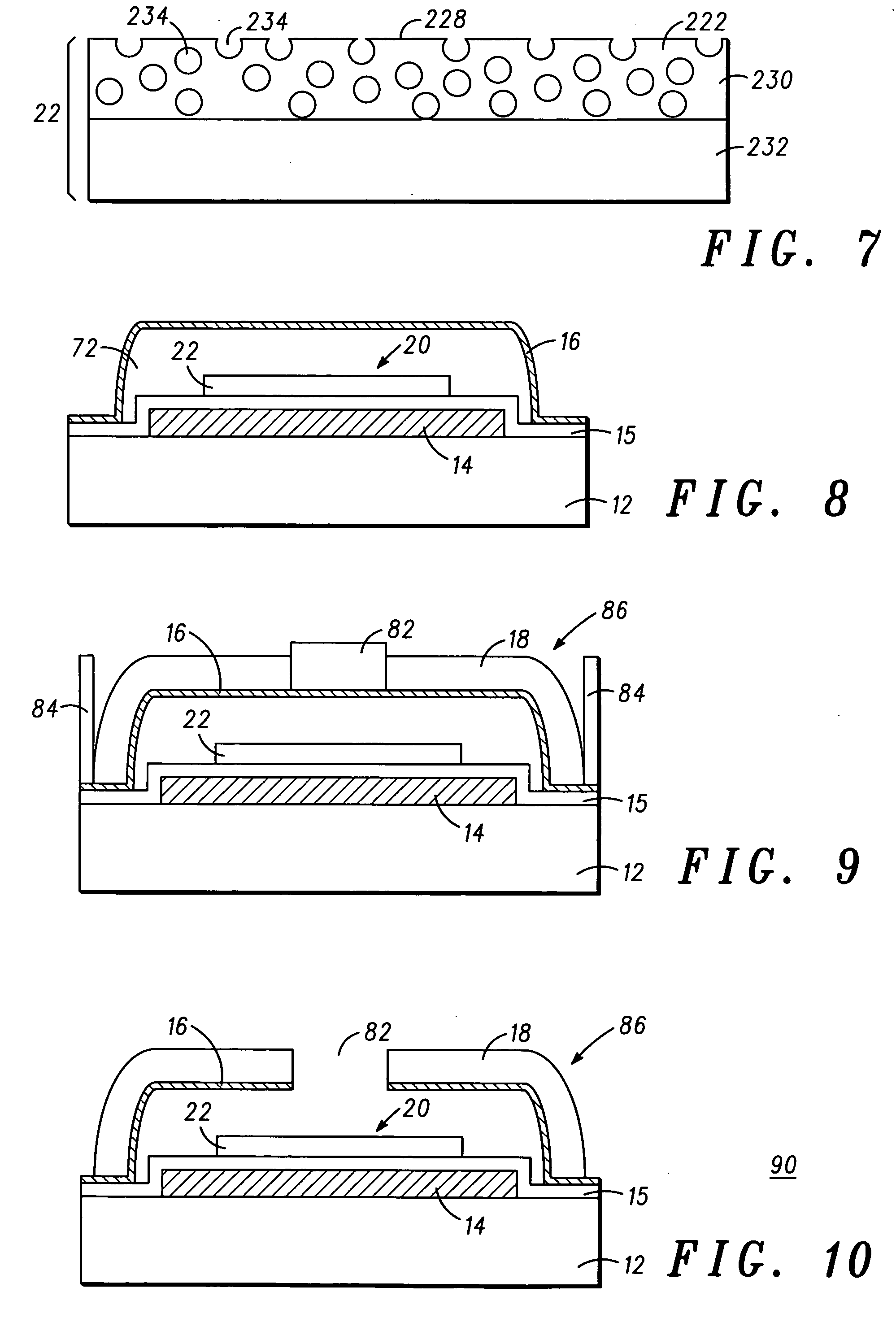Field emission display and methods of forming a field emission display
- Summary
- Abstract
- Description
- Claims
- Application Information
AI Technical Summary
Problems solved by technology
Method used
Image
Examples
example ii
[0075] 1. Immerse a borosilicate glass with a copper (Cu) metal pattern (substrate with an electrode) into a solution with 1×10−2M Mg(NO3)2 in isopropyl alcohol (IPA) and apply negative twenty volts (−20V) to the copper metal pattern while keeping a counter electrode, which can be constructed out of stainless steel, at ground for a duration of one (1) minute. The desired chemical reactions involved in this step are: [0076] Mg(NO3)2→Mg(NO3)++NO3− occurring in the solution; [0077] Mg(NO3)++2OH−→Mg(OH)2+NO3− occurring at the electrode; and [0078] Mg(OH)2 is the solid partial nano-supported catalyst that is forming at the electrode.
[0079] 2. Dry the borosilicate glass with the copper metal pattern having the partially formed nano-supported catalyst with a fifteen (15) minute bake at eighty degrees Celsius (80° C.).
[0080] 3. Immerse the borosilicate glass with the copper metal pattern having the partially formed nano-supported catalyst into a solution of 1×10−3 Fe(NO3)3·9H2O M (iron(II...
example iii
[0086] 1. Immerse a borosilicate glass with a copper metal pattern (substrate with an electrode) into a solution with 1×10−2M Al(NO3)3 plus 1×10−3 Fe(NO3)3·9H2O M in isopropyl alcohol (IPA) and apply a negative ten volt (−10V) bias to the copper metal pattern while keeping a counter electrode, which can be constructed out of stainless steel, at ground for a duration of one (1) minute. The desired chemical reactions involved in this step are: [0087] Al(NO3)3→Al(NO3)2++NO3− and Fe(NO3)3→Fe(NO3)2++NO3−occurring in the solution; [0088] Al(NO3)2++3OH−→Al(OH)3+2NO3−, Fe(NO3)++3OH−→Fe(OH)3+2NO3− and Fe(NO3)+2+3OH−→Fe(OH)3+NO3− occurring at the electrode; and Al(OH)3 and Fe(OH)3 are the solid nano-supported catalyst that is forming at the electrode.
[0089] 2. Dry the borosilicate glass with the copper metal pattern with the formed nano-supported catalyst of Al2O3 / FeOx with a fifteen (15) minute bake at eighty degrees Celsius (80° C.).
[0090] 3. Perform hot filament chemical vapor deposition...
example iv
[0091] 1. Individual nickel and aluminum sources, both are 99.9% pure, are deposited through a polymer mask (i.e., PMMA) by electron-beam co-evaporation onto molybdenum photo-resist patterned substrate (i.e. borosilicate glass with a molybdenum electrode) to form an one hundred and fifty nanometers (150 nm) thick patterned mixed metal alloy layer consisting of fifty percent (50%) nickel and fifty percent (50%) aluminum onto substrate.
[0092] 2. The photo-resist on the substrate is removed by dissolution in acetone and the mixed metal alloy layer of the prescribed pattern remained on the substrate.
[0093] 3. The substrate with the patterned mixed alloy layer is immersed for five (5) minutes into a solution containing NH4OH, H2O2, and H2O in the ratio of one to one to five (1:1:5) respectively at a temperature of forty Celsius (40° C.) with the desired chemical reaction of Al+3NH4OH→Al(OH)3+NH4+ occurring in the mixed metal alloy film to form a Ni—Al nano-supported sponge catalyst. Th...
PUM
 Login to View More
Login to View More Abstract
Description
Claims
Application Information
 Login to View More
Login to View More - R&D
- Intellectual Property
- Life Sciences
- Materials
- Tech Scout
- Unparalleled Data Quality
- Higher Quality Content
- 60% Fewer Hallucinations
Browse by: Latest US Patents, China's latest patents, Technical Efficacy Thesaurus, Application Domain, Technology Topic, Popular Technical Reports.
© 2025 PatSnap. All rights reserved.Legal|Privacy policy|Modern Slavery Act Transparency Statement|Sitemap|About US| Contact US: help@patsnap.com



